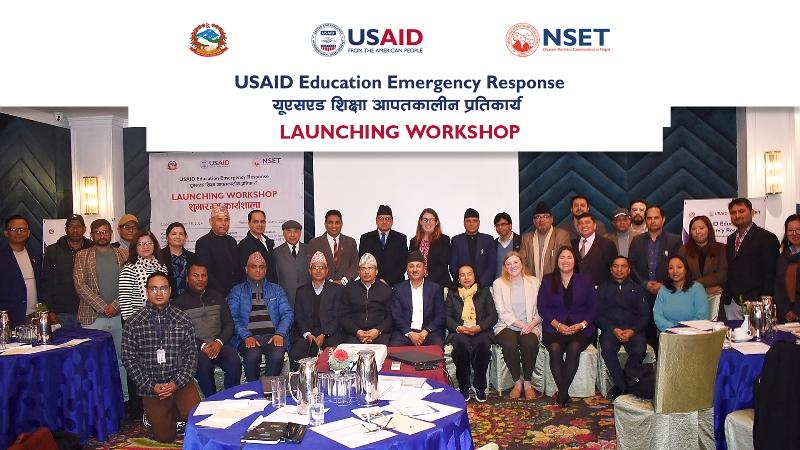
Kathmandu, December 18, 2024
The United States Agency for International Development (USAID) and the Government of Nepal launched a $5.1 million project to support restoration and recovery of the education system in earthquake affected areas of Jajarkot and Rukum West. The Government of Nepal and the United States Agency for International Development (USAID) met to jointly launch USAID Education Emergency Response, a $5.1 million USD (NPR 689 million) project to support restoration and recovery of the education system in earthquake-affected Jajarkot and Rukum West districts.
Addressing the launching event, Joint Secretary Mr. Shiv Kumar Sapkota from Ministry of Education, Science and Technology (MoEST) highlighted the urgency of learning facilities. Mr. Sapkota remarked, “the children of Jajarkot and Rukum West are in urgent need of learning facilities. The USAID Education Emergency Response Project aims to address this need by constructing transitional learning centers, alongside other supportive initiatives. I sincerely hope this thoughtfully designed project succeeds in achieving its objectives.”
To formalize this commitment a memorandum of agreement was signed by leaders from the Center for Education and Human Resource Development (CEHRD), the Central Level Program Implementation Unit (CLPIU-Education) and National Society for Earthquake Technology – Nepal (NSET) for the effective implementation of the USAID Education Emergency Response project.
USAID Mission Director Ms. Katie Donohoe noted the Jajarkot earthquake in 2023 caused significant damage to public infrastructure, destroying and damaging local schools. “The initial response coordinated by the Nepal Education Cluster addressed some of the immediate emergency needs directly following the disaster, but access to education remains limited as recovery proceeds.. USAID Education Emergency Response, a 3-year, $5.1 million program aims to support recovery efforts and strengthen community resilience in Jajarkot and Rukum West”, Ms. Donohoe stated.
The three-year project is a vital component of USAID/Nepal’s education portfolio. It is specifically designed to assist the Ministry of Education, Science, and Technology (MOEST) in addressing needs identified in the Post Disaster Needs Assessment. The NSET will implement the USAID Education Emergency Response program under the guidance of the CEHRD and CLPIU-Education.
In his remarks, Mr. Chandrakanta Bhusal, Deputy Director General from CEHRD shared, “we are now in the third year of the School Education Sector Program (SESP). One of the key objectives of SESP is to enhance children's education by ensuring learning continuity during emergencies”. Mr. Bhusal suggested the USAID Education Emergency Response ensure alignment with SESP's core values while implementing its planned activities.
NSET President Dr. Amod Mani Dixit highlighted, “the launch of the USAID Education Emergency Response project today marks a crucial step in ensuring the learning continuity for children as part of the post-Jajarkot Earthquake recovery efforts,” and added “despite a year has passed since the disaster, students continue to face significant challenges due to the lack of proper learning facilities. Establishing transitional learning centers in the area has become an urgent necessity, as waiting for the construction of permanent buildings which may take years”.
Mr. Mahendra Parajuli, Deputy Director General from CEHRD expressed his hope that this project would facilitate the restoration and recovery of the education system in these earthquake-affected areas while contributing to the long-term resilience of the education sector.
The project will construct 500 accessible Transitional Learning Centers (TLC Type2), each including two-room toilets and a hand washing station, in 13 Municipalities of Jajarkot and Rukum West. In addition, a set of teaching and learning materials (e.g. storybooks, letter and word charts, number charts, wall calendars, notebooks, pens, and other educational displays) approved and standardized by the Government of Nepal will be presented to schools. The TLCs Type2 aim to serve as safe learning facilities for a 2-3 year period until permanent schools are constructed. These efforts align with the Annual Strategic Implementation Plan and the multi-year School Education Sector Plan of the Government of Nepal. For more information about USAID/Nepal, please visit: https://www.usaid.gov/nepal
For further information:
Ramesh Guragain, PhD; Chief of Party, USAID Education Emergency Response and Acting Executive Director, National Society for Earthquake Technology - Nepal (NSET), Lalitpur, Nepal Email: rguragain@nset.org.np
Image gallery




